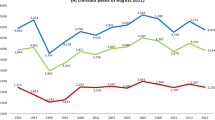Abstract
This paper validates a recently proposed method to estimate intra-generational poverty transitions through repeated cross-sectional surveys. The technique allows the creation of a “synthetic panel” – done by predicting future or past household income or consumption using a set of simple modeling and error structure assumptions – and thus permits the estimation of lower and upper bounds of the joint distribution of poverty and non-poverty transitions. We validate the approach in three different settings where good panel data exist (Chile, Nicaragua, and Peru). In doing so, we also carry out a number of refinements to the validation procedure and expand the set of tests undertaken. The results are broadly encouraging in estimating the joint probabilities of poverty and non-poverty transitions between two periods in all three contexts. The approach is also robust to a broad set of additional “stress” and sensitivity tests, especially in cases where richer model specifications can be estimated. Finally, we test whether the scope of synthetic panels can be expanded in three new directions, namely comparing between income and consumption welfare measures; the robustness to longer intervals (the approach does especially well in predicting long-term poverty transition patterns); and the robustness to two transition lines instead of one. Overall, the results lend support to the application of this approach to settings where panel data are absent.
Similar content being viewed by others
References
Bourguignon, F., Goh, C., Kim, D.: Estimating individual vulnerability to poverty with pseudo-panel data. World Bank Policy Research Working Paper No. 3375 (2004)
Bourguignon, F., Chor-ching, G., DaeIl, K.: Estimating individual vulnerability to poverty with pseudopanel data. World Bank Policy Research Working Paper No. 3375 (2004)
Dang, H.-A., Lanjouw, P., Luoto, J., McKenzie, D.: Using repeated cross-sections to explore movements into and out of poverty. J. Dev. Econ. Elsevier 107(C), 112–128 (2014)
Elbers, C., Lanjouw, J.O., Lanjouw, P.: Micro-level estimation of poverty and inequality. Econometrica 71(1), 355–364 (2003)
Author information
Authors and Affiliations
Corresponding author
Electronic supplementary material
Below is the link to the electronic supplementary material.
Rights and permissions
About this article
Cite this article
Cruces, G., Lanjouw, P., Lucchetti, L. et al. Estimating poverty transitions using repeated cross-sections: a three-country validation exercise. J Econ Inequal 13, 161–179 (2015). https://doi.org/10.1007/s10888-014-9284-9
Received:
Accepted:
Published:
Issue Date:
DOI: https://doi.org/10.1007/s10888-014-9284-9




